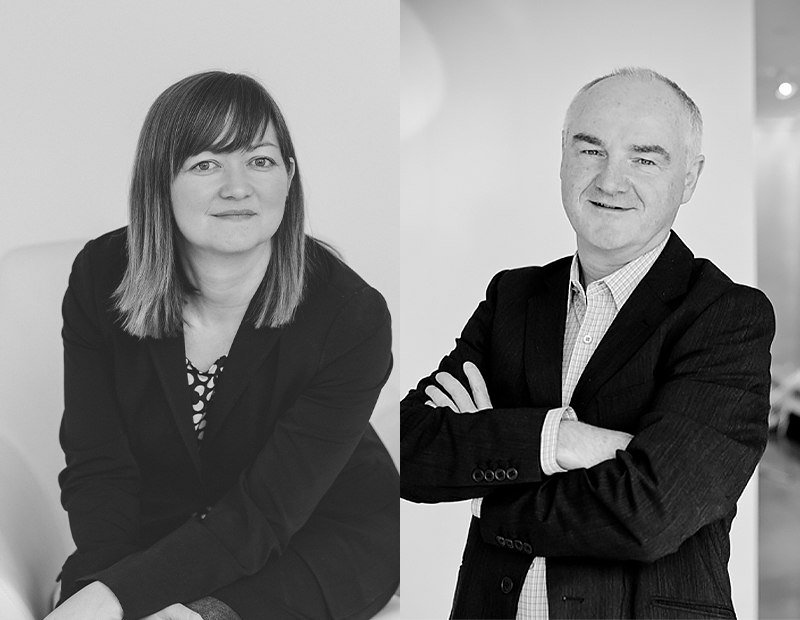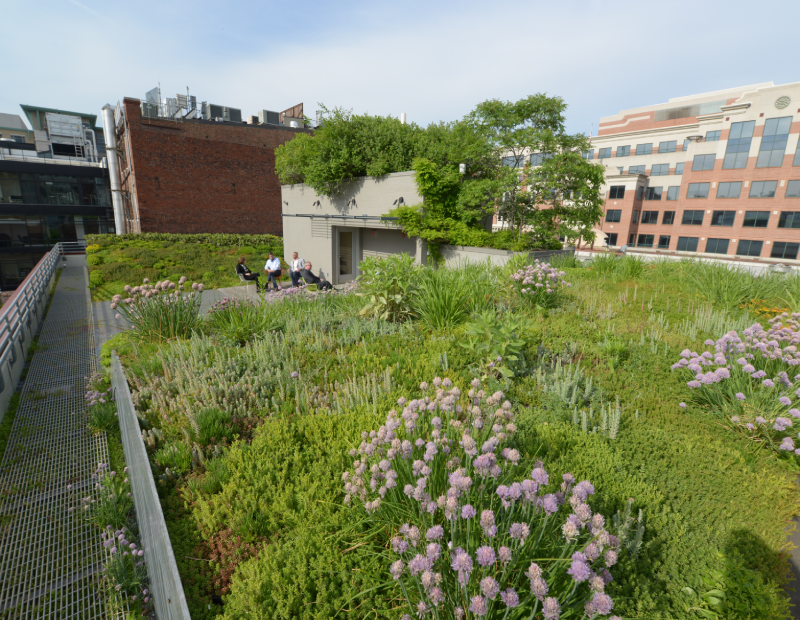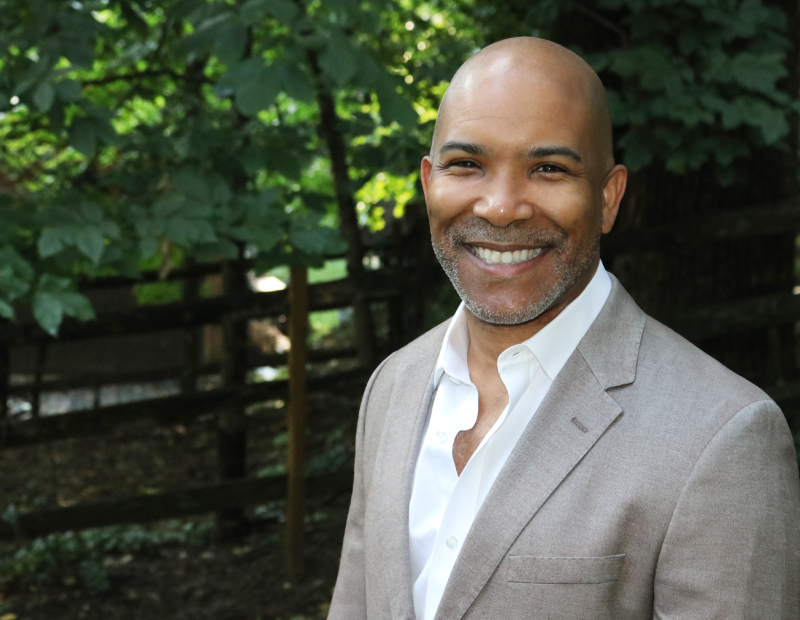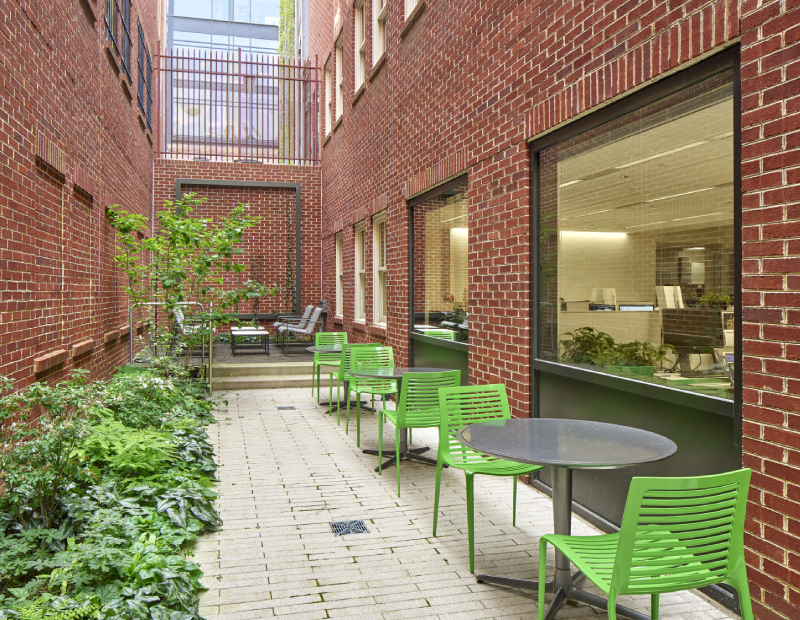Addressing World Challenges With Sustainable Measures: Q&A
Design and landscape experts at Francis Cauffman Architects and the American Society of Landscape Architects discuss green building and nature-based solutions to enhance human health and combat climate change.
Working and living in healthier buildings has been top of mind for everyone since the onset of the pandemic. Worried about indoor air quality, “tenants and building owners are exploring improvements in airflow and filtration throughout ventilation systems,” Francis Cauffman Architects President John Campbell told Commercial Property Executive.
Other trends accelerated by the health crisis include sustainable design and green building. For example, staff wellness was critical when FCA worked on the Mainline Health Lankenau Emergency Department expansion in Wynnewood, Pa. They incorporated clerestories in the perimeter treatment rooms, borrowed light within clinical space from the external corridor and skylights to bring daylight deep within the core of the staff work areas. FCA also incorporated a green roof on the top of the health-care building, a feature that can also be found at the ASLA Center for Landscape Architecture in Washington, D.C.
In the interview below, Campbell and FCA Principal Denise Thompson explore green building features pre- and post-pandemic, while Torey Carter-Conneen, CEO of the American Society of Landscape Architects talks about nature-based solutions to reduce the effects of climate change and improve human health through more outdoor recreation opportunities.
READ ALSO: Green Building Gains Territory
What is ASLA’s philosophy on sustainable design? How can it be applied across projects?
Carter-Conneen: ASLA has promoted sustainable land use, conservation of critical land and water resources, and the protection of biodiversity for over a century. Our members were promoting sustainable design and planning before most people knew what being green meant. And as the climate crisis has gotten progressively worse over the past few decades, ASLA and our members have become more active proponents of nature-based solutions to mitigate greenhouse gas emissions and help communities adapt.
ASLA co-founded and co-developed the Sustainable SITES Initiative. What can you tell us about the impact of these guidelines on the industry so far?
Carter-Conneen: The Sustainable SITES Initiative is a set of comprehensive, voluntary guidelines together with a rating system that assesses the sustainable design, construction and maintenance of landscapes—like a LEED certification—except it applies to everything but the building.
SITES can be applied to just about any project, anywhere in the world, on sites with or without buildings—from corporate campuses to streetscapes, to homes and more. Instead of supplying a set of best practices, SITES provides performance measures that can be applied to a project, supporting each site’s unique conditions and encouraging project teams to be flexible and creative as they develop beautiful, usable and sustainable landscapes.
As of right now, there are nearly 200 registered and certified SITES projects. There are 71 total certified projects—24 under the current SITES v2 rating system—and nine pre-certified projects, with pre-certification launched in 2020. Registered and certified SITES projects represent more than 727 million gross square feet of space. They are located in 38 U.S. states, Washington, D.C., and 14 countries—the U.S., Canada, Mexico, Peru, Brazil, Argentina, Uruguay, China, Thailand, Malaysia, Japan, Italy, Greece and Spain.
A few fun facts about SITES: The U.S. General Services Administration adopted SITES in 2016. Rhode Island became the first state in the nation to reference SITES in public policy as part of its Green Building Act in 2017. And just last year, in 2019, the Center for Sustainable Landscapes at the Phipps Conservatory and Botanical Gardens in Pittsburgh became the first certified Sustainable SITES Initiative v2 Platinum project in the world.
Please describe the most important features of a SITES-certified project in 2020.
Carter-Conneen: The SITES certification covers landscapes, streetscapes, parks, campuses— essentially everything but the building. SITES-certified landscapes help reduce water demand, filter and reduce stormwater runoff, provide wildlife habitat, reduce energy consumption, improve air quality, improve human health and increase outdoor recreation opportunities.
Your Center for Landscape Architecture was recently included in CPE’s top 10 LEED-certified buildings in D.C. What were the most challenging aspects of this project?
Carter-Conneen: As an organization, ASLA likes to lead by example— to turn our membership’s values and principles into tangible action. It’s one of the things that drew me to join ASLA in the first place—it truly is a mission-driven organization. The green roof demonstration project, from what I’ve been told, is a perfect example.
Having just started my tenure as ASLA CEO, I can only tell you what I’ve heard from others about the history of this project. Back when ASLA bought the office building in the Chinatown section of Washington, D.C., they did so in large part because of its central location, accessible by many forms of public transportation, so employees could easily get to work without driving. The green roof demonstration project was one of the first modifications ASLA made to the building, at a time when green roofs weren’t a common or popular feature. The goal was to create a well-designed space showcasing ASLA’s organizational values: internal and external community engagement, environmental stewardship, and human health and well-being.
ASLA made it a priority to integrate light and landscape throughout the building to demonstrate to the public the possibilities and the importance of integrating landscape into architecture, not just around it. This idea of existing as a living demonstration project framed many of the decisions around the renovation. The biggest challenge I’ve heard of is balancing the qualitative pre-conditions of the WELL building standard against the project’s high-performance goals of LEED Platinum and maintaining a conservation-first mindset throughout the process, such as when selecting efficient fixtures and then layering in water reuse/recycling as much as possible for irrigation.
How does climate change influence building and landscape design in 2020?
Carter-Conneen: Climate change is intensifying the negative impacts of standard development practices and putting people and communities at risk. We need a new paradigm for building and enhancing communities that works in tandem with natural systems and considers the needs of all. The industry will need to go beyond long-established sustainability standards in favor of building more resilient landscapes that will adapt to changing conditions.
Landscape architects plan, design and maintain spaces that can not only help communities become more resilient to climate change and adapt to new conditions but could also mitigate the damage. I expect that landscape architects will have a huge and ever-increasing role to play in the evolution of this industry—and I’m excited to be a part of it.
Thompson: The climate impact on our cities and buildings is threatening current standards in building practices that are not meeting the challenges of the environment. In the next 10 years, we will need to create new buildings with a carbon neutral footprint. Architects and builders need to do this now before we are forced to do it as a means of survival against more aggressive natural disasters due to climate change.
While there is a strong movement to address the accelerating issues of climate change, ultimately it will be legislative and enhanced building codes that will be required to provide the financial incentive to do what is right.
New projects will be more community-centric, offering mixed-use aspects to engage the local populations and enrich their place as part of the landscape where they reside. We can no longer design for “one size fits all.” We need to respond to the local challenges that each part of the country faces and address the ways in which our buildings can be more resilient in the face of those rising threats.
What should developers who apply for LEED or WELL certification know about the standards they need to achieve?
LEED is often seen as cumbersome thanks to filing and certification costs and is something that is very building-based and has benefits that may not be visually apparent to users. WELL is more operational in its approach and has long-lasting, visible benefits that impact users throughout the life of a space. Both rating systems have benefits that go beyond the upfront investment, and there is research to show high returns not only on the building systems but also, and even more importantly, the human capital.
 Are there any new green solutions that should become standard?
Are there any new green solutions that should become standard?
Campbell: One of our strategies is to investigate and review sustainable and LEED strategies early in the design stage, such as optimizing the building massing and choosing materials from our extensive library of vetted options that support sustainable goals.
There needs to be a more robust database and teaching of the costs and return on investment on sustainable practices, cradle-to-grave (C2G) accounting of material components and development process from materials extraction, processing, manufacturing, distribution, use, repair, maintenance and disposal/recycling. The current building construction model still makes it more economical to avoid sustainable and LEED practices, despite it being top of mind for so many people.
Do you think the COVID-19 pandemic has changed the perception toward green building?
Campbell: People are more concerned with indoor air quality. Everything from HVAC systems with better filtration to sterilization has been discussed recently. HVAC will be a driver in new building design, as well as a great opportunity for elevated air quality. Renovations to current systems will be increasingly more challenging and legislation for tax incentives for upgrading existing systems will go a long way in increasing the health of existing buildings.
In addition, we will see more in the implementation of smart elevator systems to minimize waiting times, which, with the reduced number of people within an elevator cab, has become an issue.











You must be logged in to post a comment.